While at ISTE last week, I had the pleasure of meeting Bob Greenberg, who interviewed me for his Brainwaves Video Anthology series. Bob seeks out "thinkers, dreamers, and innovators; some of the brightest minds in education" and seeks to record their stories to help inspire other teachers. It was an honor to be chosen by Bob to be a part of this project. Below is my 4 minute talk about the power that global service learning has had on our students at the Wallenpaupack South Elementary School.
Showing posts with label Distance Teaching Project. Show all posts
Showing posts with label Distance Teaching Project. Show all posts
Wednesday, July 8, 2015
Wednesday, May 6, 2015
Adventures in Kenya Series - Day 3 - Havilla Children's Center
Today was a great day. This morning Livingstone picked me up at Barnabas's house and walked me to the Havilla Childrens Center where I spent the day teaching, recording interviews, facilitating distance learning opportunities, and learning from the wonderful students and teachers at the school.

Havilla has about 115 Pre-K through 2nd grade students who all live in the Kibera Slum. The school does not have a lot of resources, but it does have enthusiastic students who love to learn, and teachers who are commited to helping them do that.
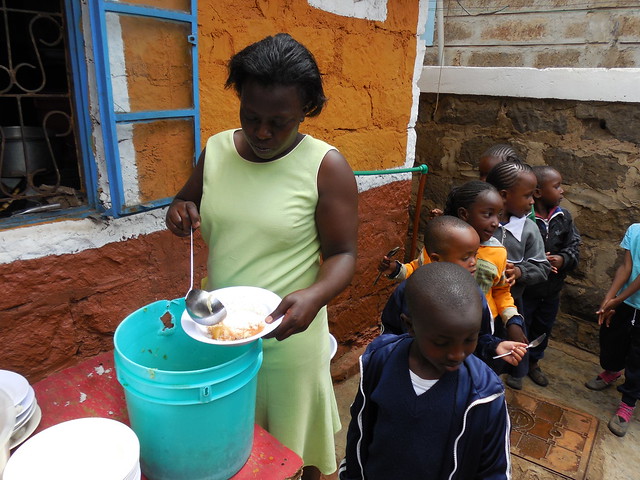
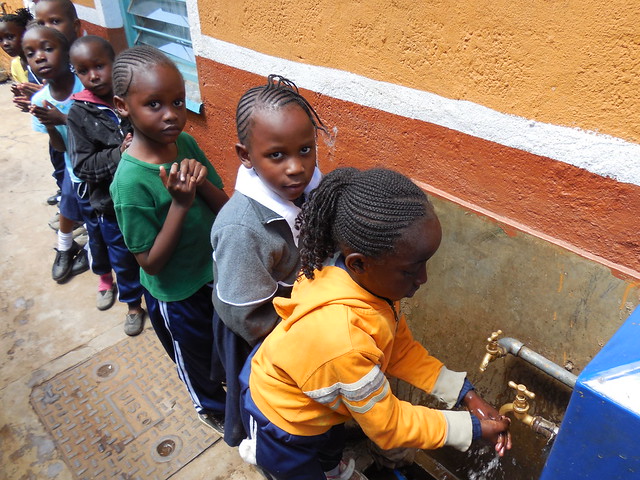

Most of the Pre-K and Kindergarten students did not understand English well enough for me to communicate much with them. They did love coming up to me and grabbing my shorts or tugging on my arm yelling "Teacher Mike!" with a big smile on their faces. They were very excited when I gave them the crayons and paper that my son Michael Jr. had raised money to buy for them. We had a great "chat" about the things that they would like to draw. They promised me to make lots of pictures and to have Livingstone take photographs to share with me. I can't wait to get them and share them with Michael.

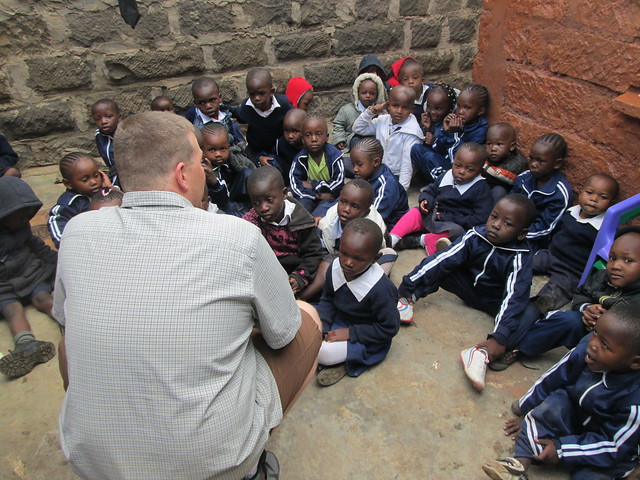
The year two students and year one students were a lot of fun to work with. I talked with the first graders about the English words they were learning and helped them find real examples in their classroom. Then, Livingstone and I connected with our friend, and fellow Skype Master Teacher, Iro Stefapoulou in Greece. The children shared the English word they were learning with Iro and showed an example. Then Iro taught them (and me) the Greek translation of the word. After they all repeated the Greek, they then taught Iro the Kiswahili translation of the word. It was an amazing learning experience for all of us, and luckily Livingstone captured it on video. When I've got some better bandwidth and upload speeds I'll get that up on YouTube and share it as well as the many other videos I shot today.
The year 2 students were awesome as well. I worked with them in their maths class - using hands on counting chips that our Wallenpaupack students had modeled with them as part of the Distance Teaching Project. The lesson would have gone on longer, but I was called out when the representatives from Vestergaard came to talk about the water filters that are being delivered tomorrow as a result of Project LINC. For those unfamiliar, Project LINC is a collaboration between Iro's students in Greece, students from the Andover Middle School, and some of our Wallenpaupack students in which money was raised to provide clean drinking water and filters for all the children at Havilla and the Cheery Children's Education Center while in school, as well as filters for many (194) of the families at home. Money is still being raised to get filters for the rest of the families.
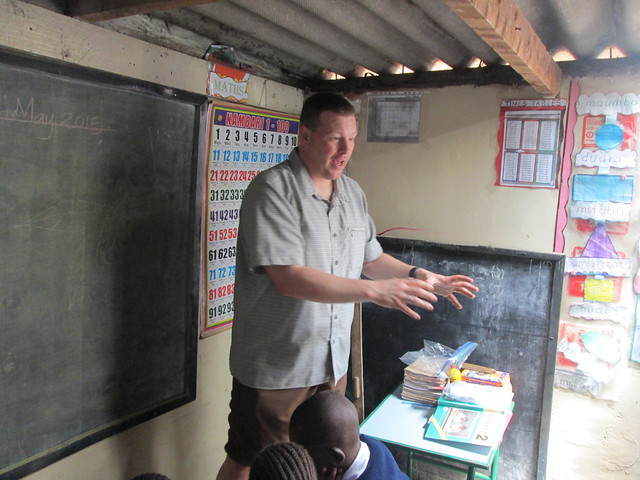
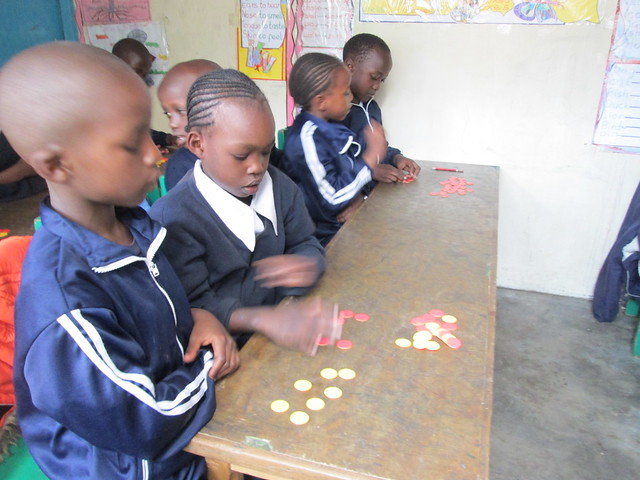

After meeting with the Vestergaard representatives and conducting a video interview with them about the project and their outreach programs, I went back to work with the year 2 students. This time we had a Skype call with Amy Weems from Louisiana. The kids shared all they knew about Kenyan foods, and "Teacher Amy" shared with them some of the foods in Louisiana. I learned that the word "gumbo" means "okra" here in Kenya. That's where the dish gets it's name. Kids here found the concept of a "pig roast" to be mind-blowing.
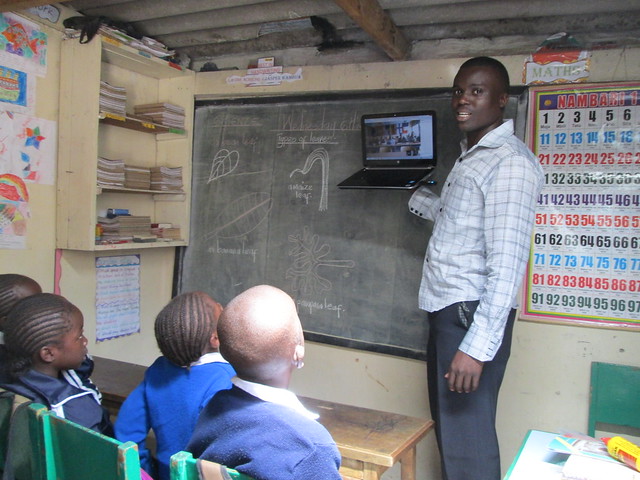
At the end of the day, Beth Heidemann's kindergarten students Skyped with the year 2 students. They had recently had a virtual field trip to the Mitahato Teaching Farm in Kenya, and they wanted to know the names of the animals in Kiswahili. They would tell us the animal they saw, and the kids here would then teach them the Kiswahili word. At the end of the call, the kids in Kibera learned how to make turkey noises, an animal of which they were previously unfamiliar.
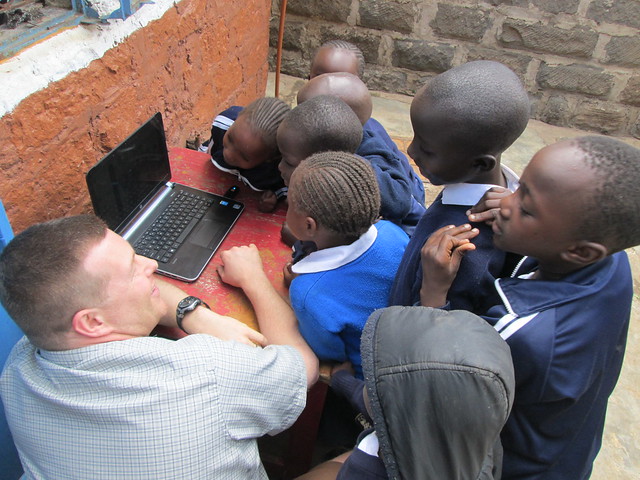
After school I came back to Barnabas's house, sent some video messages to students back home and my children, and had a Skype call with my wife. I miss Lori a lot, and it was so nice to see her face and hear her voice.
As evening aproached, Kyrsha and I went for a walk to see the local shops around this part of Kibera. There is an amazing economy here. I don't know how else to explain it other than it seems there are tiny shops everywhere selling everything you can imagine. I enjoyed talking to the produce sellers and learning some new fruits and vegetables. I bought an ear of grilled maize for a snack off one vendor to try. Odd to me, oranges here are green, lemons are green and look like large limes, and there are lots of produce items that I've never seen or heard of before.
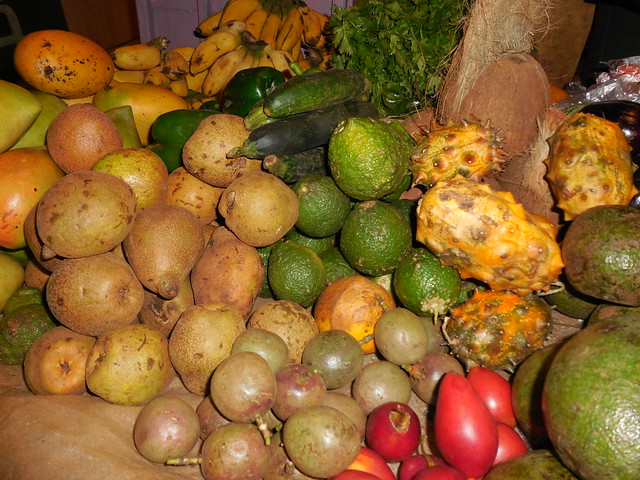
For dinner, I was again welcomed to the dinner table by Barnabas and his family along with Tracy from NGGE, Kyrsha, and a neigbor. I had ugali and liver, sauted pumpkin leaves, and rice. Ugali is a lot like polenta, and it was a very enjoyable meal. I also tried some of the local mango. I'm determined to experience things here to the fullest.
I'm exhausted, but looking forward to my time tomorrow working with teachers and students at Cheery. I've been connecting with that school for well over a year, and it will be great to see Emmily, Jairus, and the kids in person tommorrow.

Havilla has about 115 Pre-K through 2nd grade students who all live in the Kibera Slum. The school does not have a lot of resources, but it does have enthusiastic students who love to learn, and teachers who are commited to helping them do that.



Most of the Pre-K and Kindergarten students did not understand English well enough for me to communicate much with them. They did love coming up to me and grabbing my shorts or tugging on my arm yelling "Teacher Mike!" with a big smile on their faces. They were very excited when I gave them the crayons and paper that my son Michael Jr. had raised money to buy for them. We had a great "chat" about the things that they would like to draw. They promised me to make lots of pictures and to have Livingstone take photographs to share with me. I can't wait to get them and share them with Michael.


The year two students and year one students were a lot of fun to work with. I talked with the first graders about the English words they were learning and helped them find real examples in their classroom. Then, Livingstone and I connected with our friend, and fellow Skype Master Teacher, Iro Stefapoulou in Greece. The children shared the English word they were learning with Iro and showed an example. Then Iro taught them (and me) the Greek translation of the word. After they all repeated the Greek, they then taught Iro the Kiswahili translation of the word. It was an amazing learning experience for all of us, and luckily Livingstone captured it on video. When I've got some better bandwidth and upload speeds I'll get that up on YouTube and share it as well as the many other videos I shot today.
The year 2 students were awesome as well. I worked with them in their maths class - using hands on counting chips that our Wallenpaupack students had modeled with them as part of the Distance Teaching Project. The lesson would have gone on longer, but I was called out when the representatives from Vestergaard came to talk about the water filters that are being delivered tomorrow as a result of Project LINC. For those unfamiliar, Project LINC is a collaboration between Iro's students in Greece, students from the Andover Middle School, and some of our Wallenpaupack students in which money was raised to provide clean drinking water and filters for all the children at Havilla and the Cheery Children's Education Center while in school, as well as filters for many (194) of the families at home. Money is still being raised to get filters for the rest of the families.



After meeting with the Vestergaard representatives and conducting a video interview with them about the project and their outreach programs, I went back to work with the year 2 students. This time we had a Skype call with Amy Weems from Louisiana. The kids shared all they knew about Kenyan foods, and "Teacher Amy" shared with them some of the foods in Louisiana. I learned that the word "gumbo" means "okra" here in Kenya. That's where the dish gets it's name. Kids here found the concept of a "pig roast" to be mind-blowing.

At the end of the day, Beth Heidemann's kindergarten students Skyped with the year 2 students. They had recently had a virtual field trip to the Mitahato Teaching Farm in Kenya, and they wanted to know the names of the animals in Kiswahili. They would tell us the animal they saw, and the kids here would then teach them the Kiswahili word. At the end of the call, the kids in Kibera learned how to make turkey noises, an animal of which they were previously unfamiliar.

After school I came back to Barnabas's house, sent some video messages to students back home and my children, and had a Skype call with my wife. I miss Lori a lot, and it was so nice to see her face and hear her voice.
As evening aproached, Kyrsha and I went for a walk to see the local shops around this part of Kibera. There is an amazing economy here. I don't know how else to explain it other than it seems there are tiny shops everywhere selling everything you can imagine. I enjoyed talking to the produce sellers and learning some new fruits and vegetables. I bought an ear of grilled maize for a snack off one vendor to try. Odd to me, oranges here are green, lemons are green and look like large limes, and there are lots of produce items that I've never seen or heard of before.

For dinner, I was again welcomed to the dinner table by Barnabas and his family along with Tracy from NGGE, Kyrsha, and a neigbor. I had ugali and liver, sauted pumpkin leaves, and rice. Ugali is a lot like polenta, and it was a very enjoyable meal. I also tried some of the local mango. I'm determined to experience things here to the fullest.
I'm exhausted, but looking forward to my time tomorrow working with teachers and students at Cheery. I've been connecting with that school for well over a year, and it will be great to see Emmily, Jairus, and the kids in person tommorrow.
Tuesday, April 28, 2015
Adventures in Kenya Series - Less than a Week to Go
| (Image - Wikipedia Commons) |
Last spring I applied for and was approved to receive the Helen Villaume Education Enrichment Grant from the John and Helen Villaume Foundation. My proposal had three goals: to develop a Distance Teaching Project collaboration between our students and children in the Kibera Slum of Nairobi, to travel to Kenya to document the benefits of peer-teaching service projects, and to present the project and documentation at ISTE and other conferences afterward. The Distance Teaching Project has since grown to include schools in China, India, Venezuela, France, and around the United States. Also, our students have joined children in Greece and Kansas to raise money for water filters and school supplies for schools in Kibera through Project LINC. I have been invited to share these projects, as well as others our students have collaborated upon, as part of a talk on the power of partnering students with social innovators at the Africa Summit 2015, which will be held at the University of London this July.
Within a week I will embark on my trip to Kenya to document the Distance Teaching Project, to learn from teachers and students in Kibera and Kimilili, to share my expertise with teachers at three different schools, and to create some amazing leanring opportunities for our students back home in my home district. Since I anticipate this to be an experience that is potentially life-altering as well as the adventure of a lifetime, I plan to blog daily to share with all of you just as I blogged our family trip to Europe in 2012. This is the first post in the series.
| Kibera Slum (Image - Wikimedia Commons) |
One development that has happened since I wrote the grant is our students' involvement in Project LINC. Wallenpaupack children have raised over $800 for water filters and over $600 for school supplies for kids in Kibera. Overall, the project has raised over $6000 for water filters, and the Vestergaard company that produces LifeStraw filters has generously agreed to donate 7 large community filters for the schools in Kibera with which we have been working. I am excited that these water filters will be delivered to families and installed at the Havilla Children's Center and the Cheery Children Education Centre while I am there. I will be able to shoot video and pictures of this event and I plan to do a live Skype call at that time with children from Greece, Kansas, and home who participated in the fundraising.
I am appreciative to my good friend Livingstone Kegode, who has helped create the projects mentioned above, and has helped me plan my upcoming trip. None of this would have been possible without his guidance. I am so happy that I will get to recipricate when he visits the United States in June/July to present the Distance Teaching Project with me at ISTE.
As of right now, here is my anticipated schedule for the trip:
Sunday 5/3 - Depart Newark for overnight flight to Amsterdam
Monday 5/4 - Layover in Amsterdam. Since it's Remembrance Day in the Netherlands, I am going to do an interview with a Dutch friend to answer questions about this holiday and the Canadian liberation of the Netherlands from the Nazis in WWII. Also, take a canal tour and have lunch at a nice cafe by a canal. Maybe buy some clogs. Overnight flight to Nairobi.
Tuesday 5/5 - Arrive Nairobi. Shop for school supplies.
Wednesday 5/6 - Work with teachers and students at the Havilla Children's Center. Filters will be delivered to the two schools on this day. Shoot footage and pictures to document Distance Teaching Project
Thursday 5/7 - Work with teachers and students at the Cheery Children Education Center. Shoot footage and pictures to document Distance Teaching Project.
Friday 5/8 - I will be spending time at both of the forementioned schools working with teachers and students, and documenting the instillation of the filters. If all goes as planned I will facilitate a group Skype call with Wallenpaupack students, children from Andover, Kansas, and children from Trikala, Greece to let them see how much good they have done through their project. There is no better feeling as a teacher than seeing your students experience the joy that comes from using their learning to help others.
Saturday and Sunday 5/9-10 - For my birthday, my wife got me a one-night flying safarin to the Masai Mara. I will be leaving Nariobi Wilson airport on a tiny turbo-prop plane and flying into the Mara, where I will spend two days on game drives. My children are excited because this is the same location that "Big Cat Diary" is filmed that they sometimes watch on Animal Planet. I fly back to Nairobi on Sunday night.
Monday 5/11 - Livingstone and I are leaving way before dawn to drive the 5-6 hours to Kimilili, a rural area of western Kenya, where we will spend time working at the HIP Academy. This school opens for the first time next week. I will be taking hands-on math materials to the teachers there and giving them training in how to use them with students.
Tuesday 5/12 - We will spend the morning at HIP Academy, and then travel 3-4 hours east to Lake Nakuru National Park, where I have arranged to stay for two nights at the Naishi House - a former Game Warden's residence in the middle of the park that is run by the Kenyan Wildlife Service. There are no fences around this house, and animals literally are all around where we are staying. Lake Nakuru NP is famous for it's huge number of Flamingos, as well as other traditional safari animals like rhinos and lions. We will use the house as a base for exploring the park.
Wednesday 5/13 - While at Lake Nakuru NP this day, I have arranged for a game warden to meet us at the Naishi House to record an interview about the park and the animals in Kenya. If we can work out the timing and internet connectivity we will do this interview as part of a live Skype call with Wallenpaupack students and others from around the globe who wish to join. If not, I will record the interview and post it online for students to access.
Thursday 5/14 - I have an 11PM flight out of Nairobi to come home. There are a couple of options before I fly home. Either we will come back to Nairobi and see a bit of the city, spend some time at Nairobi National Park within the city's borders, or stop at the Mitahato Teaching Farm on the way back to the city. The Teaching Farm is a location about 45 min north of Nairobi where a 1/4 acre farm has been engineered to provide food for an entire community. Kenyans travel from rural areas to learn here how to replicate this in their own villages. Mitahato has agreed to partner with our students next year as we build a community garden that will grow food for our local food pantry, so I would like to stop there if we can.
So, this is the plan. We all know how plans go. I fully expect that flexibility will be needed during my travels, and that the unexpected will happen at times. Regardless, I hope that I can do some good during the trip, learn lessons that help me grow as a teacher and a person, bring experiences to our students at home, and make connections that lead to future projects. I know that I'll meet lots of people and add many teachers to my global network.
In the next few days before I travel I'll share my packing list.
| (Image - Wikimedia Commons) |
Monday, January 5, 2015
Easy to Make Fraction Wheels
Fractions are often a difficult concept for students to visualize. Today I had the pleasure of working with a group of 5th grade students. In order for them to show their knowledge of fractions, we spent 15 minutes creating fractions wheels. Below is a step-by-step guide on how to do this with your own students.
Materials needed: Cheap white paper plates, marker or crayon, scissors, ruler
First, have students completely color one of the plates.
Finally, place one plate on top of the other and twist them so they interlock where they have been cut. This will allow students to rotate the plates to create representations of different fractions. We spend a bit of time having them showing different fraction representations and explaining why they believed those representations to be accurate.
Materials needed: Cheap white paper plates, marker or crayon, scissors, ruler
First, have students completely color one of the plates.
Next, have them use the ruler to find the center point of both plates. This is a great time to introduce or review vocabulary having to do with circles such as "diameter", "radius", "chord", etc.
When they have found the center of both plates, have them cut the radius of each plate.
Finally, place one plate on top of the other and twist them so they interlock where they have been cut. This will allow students to rotate the plates to create representations of different fractions. We spend a bit of time having them showing different fraction representations and explaining why they believed those representations to be accurate.
After spending some time exploring fraction concepts, students will use their creations to teach those concepts to other students around the world through short videos as part of the Distance Teaching Project.
Wednesday, December 17, 2014
Global Holiday Song Exchange Skype-a-Thon
The following post is cross posted from the "21st Century Learning at the South Elementary" blog that I also author. There I post the great learning experiences that we bring to our students. Unfortunately, with all that is happening lately, I have struggled to keep up with sharing some of those great experiences here. I am going to try cross-posting some of my favorite activities in both places to see if I can do a better job sharing with you all.
Global Holiday Song Exchange Skype-a-Thon
Yesterday the students at the South Elementary got to experience one of the great joys of the holiday season - music from around the world. Through Skype, our students took part in seven different group calls that allowed them to exchange holiday songs with students from five different continents.
The planning of the project over the past 2 weeks was done with the help of a lesson posted on the Skype in the Classroom website. We asked for classrooms in other locations to contact us if they wished to participate. Many of our connections were made through that posting. We wanted to make sure that we had 2 other classrooms connecting with us in each of our time slots. During our group calls, each class had the opportunity to sing three of their favorite holiday songs for their partner classes.
The first call of the day partnered our 3rd grade students with children in Russia and Poland. Some of the Russian students dressed up as traditional holiday characters from their country: Papa Frost and his granddaughter who deliver presents to children on New Year's Eve.
Our next session partnered our 3rd graders with students in France and Venezuela. A French newspaper wrote about the interaction here: Mende : Jeanne-d’Arc connectée au reste de la planète. The highlight of this call was when all three schools sang "Jingle Bells" in their own language. It was a beautiful three-continent, three-language sing along.
The third group call connected students in Mrs. Spitzer's homeroom with students in Greece and Canada. Our Greek friends shared a bit about their Christmas traditions and insisted on taking a three-country picture at the end of the call.
Our fourth connection stayed within the United States. Mrs. Gates's second grade class connected with schools in Massachusetts and Delaware.
Session five also stayed within the United States. Our 4th and 5th grade chorus got the opportunity to share the songs they had been practicing with a Middle School chorus in Virgina and a group of 4th grade students in Utah. There was some fantastic singing going on during this call as you can see in the video below.
The sixth session of the day of the day brought countries in North America together. Second grade students in Mrs. Gates's and Mrs. Seifert's classes and Mrs. Conklin's Kindergartners sang for and with students in Mexico and Canada. Since the Mexican students spoke Spanish and the students in Canada were French speaking, there was another multi-language caroling activity at the end of the call.
Our last connection of the day was between Mrs. Flynn's second grade students, first graders in Colorado, and third graders in Hawaii. The Colorado students played the xylophone along with their songs. The Hawaiian students sang a unique version of "The 12 Days of Christmas" that substituted in gifts from Hawaii like coconuts, giant squid, and papaya trees.
In addition to our seven connections during the day, classrooms that could not connect live due to time zone restraints or holiday breaks sent us videos of their students singing. We received videos from Serbia, India, France, and Kenya. Those videos can be seen on the Distance Teaching Project website and will be played as part of our morning news broadcast during the next few days.
This was an amazing experience for everyone who participated. We've already had multiple requests to plan another Holiday Song Skype-a-Thon for next year.
Global Holiday Song Exchange Skype-a-Thon
 |
| South Elementary music teacher Jean Shields leads 3rd grade students in song. |
The first call of the day partnered our 3rd grade students with children in Russia and Poland. Some of the Russian students dressed up as traditional holiday characters from their country: Papa Frost and his granddaughter who deliver presents to children on New Year's Eve.
The sixth session of the day of the day brought countries in North America together. Second grade students in Mrs. Gates's and Mrs. Seifert's classes and Mrs. Conklin's Kindergartners sang for and with students in Mexico and Canada. Since the Mexican students spoke Spanish and the students in Canada were French speaking, there was another multi-language caroling activity at the end of the call.
Our last connection of the day was between Mrs. Flynn's second grade students, first graders in Colorado, and third graders in Hawaii. The Colorado students played the xylophone along with their songs. The Hawaiian students sang a unique version of "The 12 Days of Christmas" that substituted in gifts from Hawaii like coconuts, giant squid, and papaya trees.
Subscribe to:
Posts (Atom)





